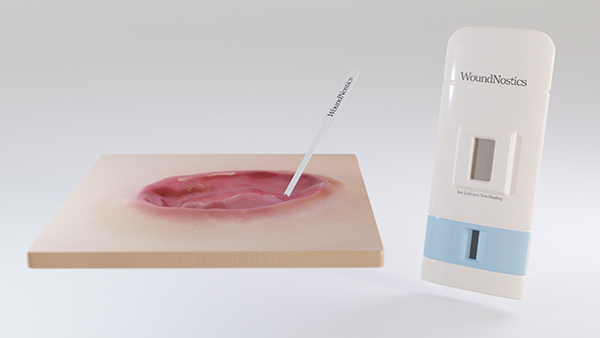By Marianne Stacey,
The extent and the burden of chronic wounds in Canada, in people worldwide has been well documented in multiple publications. Chronic are increasing at a very high rate and can lead to complications that can impact quality of life including infection, sepsis, amputation and even death. The key challenge in treating such wounds is that current traditional assessment can take a number of weeks to identify if a wound is progressing or not and at what point do clinicians modify the treatment?
There are two key questions we ask ourselves when the wound healing process is impeded:
- a) How do we accurately know the wound is in a healing status?
- b) Of the numerous advanced wound care products on the market, do we have a full understanding of what therapies to utilise?
Dr. Michael C. Stacey, Vascular Surgeon and currently the CME & Executive VP Academic at the Hamilton Health Sciences, specializes in wound healing and finding ways to advance diagnostics. His most recent publication in The Journal of Wound Repair and Regeneration, validates that we can advance wound healing with innovative point of care diagnostic testing and link therapeutic options that will revolutionize wound care for patients, clinicians and health care funding.
Let’s first take a look at the current approach to treating a chronic wound which is to:
- Determine the underlying cause of the wound.
- Conduct an initial baseline assessment of the wound and identify a treatment best suited to the type of chronic wound. Eg. pressure offloading, revascularisation or other options for different types of chronic wounds.
- Apply an Advanced Wound Dressing technology by which a clinician has many options such as wound debridement, dressings that regulate bacteria/biofilm, Protease inhibitors, the addition of a matrix, negative pressure, growth factors, cellular components, oxygen therapy or other modalities.
- Monitor the healing process by observation, measurement, photography, imaging and documentation on a regular basis.
- At best it can take 3-4 weeks to determine through assessment that a wound is not healing, when time is of essence.
Globally, there are great advances in educating the clinicians specifically in the care of wounds and understanding the possibilities available for the most appropriate treatment. But not all clinicians have this opportunity for training. As a result, there is a limited structured approach in many areas and changing treatment can be slow, random, and result in wounds have prolonged healing periods.
We cannot forget during these times of COVID -19 and especially in community and remote settings. There is a large gap in patient’s ability to access patient virtual care and it is becoming more and more important that the clinician has the tools and education to provide the most optimal treatments for their patients and have accurate test results to discuss with a specialist.
Patients with Chronic Wounds and additional co-morbidities are at higher risk for COVID- 19 and it is essential to avoid admission to hospitals which are already to capacity and where there can be further exposure.
An exciting new innovation in biomarker based diagnostic technology has developed in light of new research that has identified a biomarker which can be measured in wound fluid to determine the status of wound healing in venous leg ulcers.
This research has identified that GM-CSF (Granulocyte macrophage colony stimulating factor) has a 92% accuracy at determining the healing status of a wound and a 96% sensitivity at determining if a wound is not healing. We have initiated the same study in the Diabetic Foot Ulcer population.
WoundNostics Inc., is a Canadian based start – up company and is very excited to share that we have obtained the world – wide rights to advance this technology and to develop a pocket – sized point of care test that clinicians can use immediately. The diagnostic will indicate a wound is not healing and the results can direct wound treatments in real time. With the support of investors, this technology will take approximately 12 months to develop to be ready for manufacture.
To summarize, there is great value for the clinician in utilizing a point of care diagnostic:
- Knowing in real time, in the community, hospital or clinic, that the wound is not healing the clinician immediately change treatment.
- Provision of an APP which links the knowledge of the wound’s healing status to a hierarchical algorithm of advanced wound treatments on a mobile device for easy access and education.
This would eliminate weeks of not knowing the status of wound healing. Aligning a point of care test of healing status of a wound with a hierarchical algorithm of therapies will facilitate more expedient decision making which leads to increased quality of life for the patient, faster healing times, fewer complications and less burgeoning costs to the health care system.
One of the top global specialists in Diabetic Foot Ulcers and Limb Salvage, Dr. David Armstrong, Director, Southwestern Academic Limb Salvage Alliance, in support of new wound advancements in diagnostics, provided us with the following quotation. “To say we’re enthusiastic about this space and “measuring what we manage” is an understatement. Here’s to that next jump in wound navigation.”
Our vision at WoundNostics Inc. is to develop a panel of point of care tests which will also evaluate the cause of non-healing status of the wound upon initial evaluation which will then direct the optimal therapy for a patients wound. This will add to the customization of the patients managed care and improve the quality of life for our patients.
Marianne Stacey is Chief Executive Officer, WoundNostics Inc. Canada




